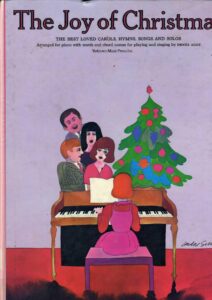Carol of the Bells Shchedryk – Mykola Leontovych based on Ucranian Christmas Carol Easy Piano arr.

Best Sheet Music download from our Library.
Please, subscribe to our Library. Thank you!
‘Shchedryk’ (in Ukrainian: Шчедрик, which comes from Шчедрий вечир, and which translated into Catalan would be ‘Abundant Evening’ or xixèdric) is a Ukrainian shchedrivka, or New Year’s song, known in English as ‘The Little Swallow’.
It was composed by the composer and teacher Mykola Leontovych in 1916, and tells the story of a swallow that flies into a house to sing of the wealth that will come the following spring. ‘Shchedryk’ was originally sung on the night of January 13, New Year’s Eve in the Julian calendar (December 31 old style), which is Shchedry Vechir. The first interpretations of the work were performed by students of the University of Kyiv.
‘Shchedryk’ was later adapted as an English carol under the title ‘Carol of the Bells’, by Peter J. Wilhousky after a performance of the original song by Alexander Koshetz’s Ukrainian National Chorus at Carnegie Hall on October 5, 1922.
Wilhousky obtained the copyright and published his new lyrics (which were not based on the Ukrainian lyrics) in 1936, and the song became popular in the United States and Canada, where it became strongly associated with the Christmas
Conceptually, the Ukrainian lyrics of this song meet the definition of shchedrivka, while the English content of ‘The Little Swallow’ identifies it as kolyadka.
Shchedryk (‘Generous Stained Glass’) is a Ukrainian shchedrivka or New Year’s song, known in English as ‘The Swallow’. It tells the story of a swallow that flies into a house to proclaim the full and abundant year that the family will have.
The title derives from the Ukrainian word for ‘abundant’. The song is based on a traditional folk song whose language was thought to have magical properties.
The original traditional Ukrainian text used a device known as a hemiola in rhythm (alternating accents within each bar from 3/4 to 6/8 and vice versa). Singing based on an ostinato pattern of four notes within the range of a minor third is believed to be of prehistoric origin and was associated with the approaching New Year, which in Ukraine before the introduction of Christianity was originally celebrated in April. Conceptually, the Ukrainian lyrics of this song meet the definition of shchedrivka, while the English content of ‘The Little Swallow’ identifies it as kolyadka.
With the introduction of Christianity in Ukraine, the celebration of the New Year was moved from April to January and ‘Shchedryk’ became associated with the feast of the Epiphany also known in Ukrainian as Shchedry vechir, on 18 January in julian calendar It was originally sung on the night of January 13, New Year’s Eve in the Julian calendar (December 31 old style), which is Shchedry Vechir. In modern Ukraine, the song is sung again on the eve of the Julian New Year (January 13).
The four-note melody over a minor third of the chant was used by Ukrainian composer and teacher Mykola Leontovych as an ostinato theme in several arrangements he made. It is the most famous of all his songs.
It is generally said that ‘Shchedryk’ was first performed by students of Kyiv University on 25 December 1916. However, it was first performed on 29 December 1916 in the Assembly Hall of Merchants of Kyiv, now part of the National Philharmonic of Ukraine.
The arrangement for a cappella mixed voice choir was popularized by the Ukrainian Republic Capella conducted by Oleksander Koshetz when it toured Europe in 1920/21. The first recording was made in New York in October 1922 for Brunswick Records.
‘Shchedryk’ was later adapted as an English Christmas carol, ‘Carol of the Bells’, by Peter J. Wilhousky of NBC Radio, following the performance of the original song by Alexander Koshetz’s Ukrainian National Choir at the Carnegie Hall on October 5. 1922.
Wilhousky copyrighted and published his new lyrics (which were not based on the Ukrainian lyrics) in 1936, and the song became popular in the United States and Canada, where it became strongly associated with the Christmas
Although ‘Carol of the Bells’ uses the melody of ‘Shchedryk’, the lyrics of these two songs have nothing in common. The ostinato of the Ukrainian song suggested to Wilhousky the sound of bells, so he wrote lyrics about it. Several other lyricists have written for the same tune, generally retaining Wilhousky’s bell theme. A 1947 version, ‘Ring, Christmas Bells’, is a Christian devotional song.
There is also an English adaptation of the Ukrainian original by Stepan Pasicznyk.

